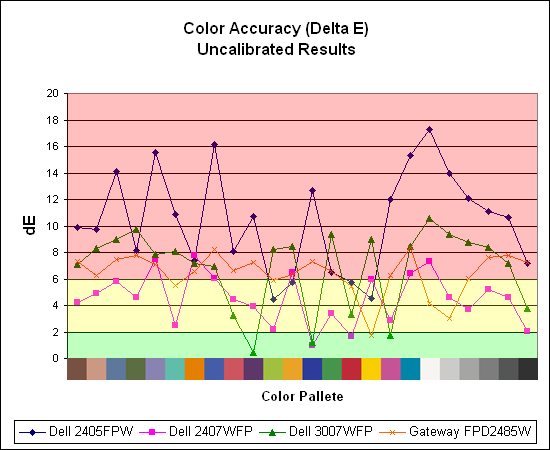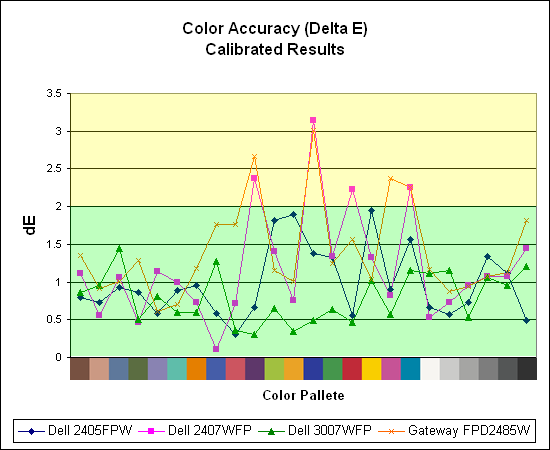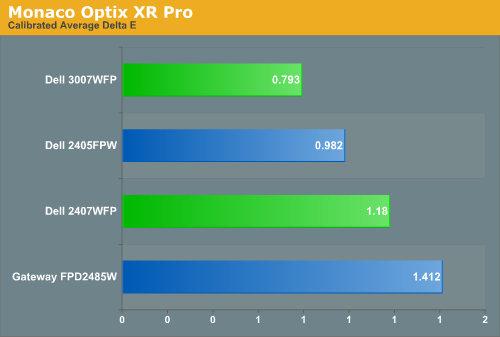Dell 2407WFP and 3007WFP LCD Comparison
by Jarred Walton on March 2, 2007 11:30 AM EST- Posted in
- Displays
Color Accuracy
Something far more important than contrast ratio or brightness is the accuracy of the colors that are produced. A bright display with a high contrast ratio could still have terrible color reproduction, and it's not always possible to correct this. Most people will simply "eyeball" the display output to try and determine what looks best, and there are various color charts available online that can help. Outside of image professionals, that is often sufficient, and most users will find that their eyes adapt to whatever display they use and it is only when doing side-by-side comparisons that differences become apparent.
Monaco Optix XR Pro was used to generate reports of color accuracy, after performing initial calibration using the software. 24 color patches are sent to the display with the colorimeter measuring the resulting values. The difference between what is requested and what the LCD actually shows is known as Delta E, with lower values being better. Any score less than one is basically "perfect" - the naked eye is not going to be able to tell the difference - and scores less than 2.0 are very nearly perfect. Ideally, you would want all of the tested colors to have a Delta E of less than 1.0, but almost no one is likely to have problems with anything scoring below 2.0. From 2.0 to 4.0, most people still won't notice the slight inaccuracies in the color palette, but when comparing displays side by side it might be noticeable -- multimedia professionals would prefer something a bit better. Anything above 4.0 begins to represent a more significant deviance, and numerous scores above 6.0 will almost certainly be noticeable by just about anyone using the display.
The problem with calibrating a display is that it doesn't help all applications. Specifically, the video overlay used when watching DVDs or other movies completely bypasses any color correction, so you are essentially stuck with the uncalibrated colors. It is possible to tweak things slightly on some LCDs using the OSD, but the amount of color correction that can be done via the OSD pales in comparison to color profiles, and on models like the Dell 3007WFP there is no option to adjust colors outside of software. Ideally, we would like to see video drivers begin to apply color profiles to the overlay output as well, but we're not sure how much work that would require -- or if it's even possible.
We'll start with the uncalibrated results, as that is closer to what many people will experience. We should also note that color accuracy can vary from panel to panel even within the same model, so the results we are reporting are only from looking at a single LCD.


Without any form of color correction, the color accuracy of all of these displays is pretty poor. The good news is, for a lot of people it won't matter all that much. As we mentioned before, your eyes and brain tend to adapt to whatever you see, and for a lot of people they might notice a difference between displays but they would have difficulty quantifying one as substantially better. Subjectively, the only display out of these four that was discernibly worse was the old 2405FPW. While our instruments are able to measure extremely small Delta E differences, anything less than 3.0 is usually good and up to around 6.0 is "good enough".


If the uncalibrated results are disconcerting, at least the good news is once you calibrate any of these displays you end up with very good results. Of the four displays we've looked at so far, the 3007WFP ends up having the best color accuracy. This could very well be attributed to the use of an S-IPS panel as opposed to the S-PVA panels used in the other three LCDs. Surprisingly, the 2405FPW still comes in second place once calibrated, although differences of a few tenths generally amount to splitting hairs. We should also note that the variation between calibration runs tends to be about 0.2, and over time you will need to adjust the color profile in order to maintain accurate colors. Basically, if having accurate colors is important to you, you will probably want to invest in some hardware to help out.
Update: Additional information on viewing angles and color calibration for print work with these displays is available in our Acer AL2216W review.
Something far more important than contrast ratio or brightness is the accuracy of the colors that are produced. A bright display with a high contrast ratio could still have terrible color reproduction, and it's not always possible to correct this. Most people will simply "eyeball" the display output to try and determine what looks best, and there are various color charts available online that can help. Outside of image professionals, that is often sufficient, and most users will find that their eyes adapt to whatever display they use and it is only when doing side-by-side comparisons that differences become apparent.
Monaco Optix XR Pro was used to generate reports of color accuracy, after performing initial calibration using the software. 24 color patches are sent to the display with the colorimeter measuring the resulting values. The difference between what is requested and what the LCD actually shows is known as Delta E, with lower values being better. Any score less than one is basically "perfect" - the naked eye is not going to be able to tell the difference - and scores less than 2.0 are very nearly perfect. Ideally, you would want all of the tested colors to have a Delta E of less than 1.0, but almost no one is likely to have problems with anything scoring below 2.0. From 2.0 to 4.0, most people still won't notice the slight inaccuracies in the color palette, but when comparing displays side by side it might be noticeable -- multimedia professionals would prefer something a bit better. Anything above 4.0 begins to represent a more significant deviance, and numerous scores above 6.0 will almost certainly be noticeable by just about anyone using the display.
The problem with calibrating a display is that it doesn't help all applications. Specifically, the video overlay used when watching DVDs or other movies completely bypasses any color correction, so you are essentially stuck with the uncalibrated colors. It is possible to tweak things slightly on some LCDs using the OSD, but the amount of color correction that can be done via the OSD pales in comparison to color profiles, and on models like the Dell 3007WFP there is no option to adjust colors outside of software. Ideally, we would like to see video drivers begin to apply color profiles to the overlay output as well, but we're not sure how much work that would require -- or if it's even possible.
We'll start with the uncalibrated results, as that is closer to what many people will experience. We should also note that color accuracy can vary from panel to panel even within the same model, so the results we are reporting are only from looking at a single LCD.


Without any form of color correction, the color accuracy of all of these displays is pretty poor. The good news is, for a lot of people it won't matter all that much. As we mentioned before, your eyes and brain tend to adapt to whatever you see, and for a lot of people they might notice a difference between displays but they would have difficulty quantifying one as substantially better. Subjectively, the only display out of these four that was discernibly worse was the old 2405FPW. While our instruments are able to measure extremely small Delta E differences, anything less than 3.0 is usually good and up to around 6.0 is "good enough".


If the uncalibrated results are disconcerting, at least the good news is once you calibrate any of these displays you end up with very good results. Of the four displays we've looked at so far, the 3007WFP ends up having the best color accuracy. This could very well be attributed to the use of an S-IPS panel as opposed to the S-PVA panels used in the other three LCDs. Surprisingly, the 2405FPW still comes in second place once calibrated, although differences of a few tenths generally amount to splitting hairs. We should also note that the variation between calibration runs tends to be about 0.2, and over time you will need to adjust the color profile in order to maintain accurate colors. Basically, if having accurate colors is important to you, you will probably want to invest in some hardware to help out.
Update: Additional information on viewing angles and color calibration for print work with these displays is available in our Acer AL2216W review.










62 Comments
View All Comments
Resh - Saturday, March 3, 2007 - link
Thanks Jarred!I wouldn't expect you to print and assess accuracy, but if you could do a photo-specific calibration and test for future reviews, that would be great.
Thanks again and keep up the good work!
BPB - Friday, March 2, 2007 - link
I have two questions. In the Gateway review you mentioned the Gateway did a good job of showing 16:9 movies with the black bars and that the Gateway did 1:1 very well. You also mentioned that you heard the Dell maybe didn't do it as well. So the first question is: did you try this in your test? I just bought the Gateway and like it (I opened the box last night, hours before you posted this review), but I plan on using it to watch DVD's while I work out, as well as using it as my main monitor.The second question is does the Dell have auto-rotate software like Gateway's EzTune? I was told by a Dell rep that it doesn't and that you have to manually change the video drivers. I like to use rotate when working on a website. I can often fit an entire site up and down when rotated. At most I have to scroll very little.
Oh well, looks like I may have to beg BestBuy to take the FPD2485W back and head up to Costco for the Dell if the Dell does DVD's as well. Of course then the Dell would be a little more as I didn't pay tax or shipping for the Gateway (thanks, NH!) but would have to pay tax for the Dell (arghh to you, MA) making the $5 list price favor of the Dell become a $28.70 favor for the Gateway. I paid $679.99 for the Gateway, the Dell becomes $707.70 with tax.
JarredWalton - Friday, March 2, 2007 - link
Dell locks the scaling to what your drivers specify if you use DVI. ATI doesn't allow 1:1 scaling as far as I know, but they do allow a centered 1:1 image (i.e. black bars). NVIDIA has better options for changing scaling, although I have encountered bugs in the past with their 1:1 scaled option. The Gateway does have controls more like the old 2405FPW (where you could set scaling via the monitor rather than in drivers), but the colors aren't as good overall. In terms of DVD playback, neither display is really good (i.e. less than 3 delta E), and I don't know that subjectively I can see a big difference between the Dell and GW when watching videos. You can always disable DirectDraw to get the color profile applied (it disables overlay)... heh.JarredWalton - Friday, March 2, 2007 - link
Oh, I forgot to say, I don't think there's an auto-rotate software with the Dell. Also, I'm not sure EZtune handles the auto-rotate - I thought it was a function of the drivers, but I could be wrong. I'll have to test it later... right now I need sleep! ;)BPB - Friday, March 2, 2007 - link
Thanks for the quick reply. I had a Gateway 21" before getting the 24" and can attest to the EzTune doing the auto-rotate. It's a very nice feature. Not a deal-breaker type of thing, but it's nice. When I consider the effort it will take to return the Gateway to get the Dell I start to think it probably ain't worth it, the effort, that is.chizow - Friday, March 2, 2007 - link
The 2407WFP REV A04 does 1:1 scaling. It looks like Jarred got an A03 or earlier for the review. I saw the 1:1 scaling option greyed out in the OSD but didn't see it directly mentioned in the review anywhere.Jarred, you gotta include this kind of stuff in your reviews! Its what panel buyers want to know. Also was the 3007 the HC version or standard?
Otherwise nice review; the difference between the 2407 and the FPD2485W is spot-on with my own observations from using both first hand. The one test I felt was flawed was comparing the 2405 and 2407 for input lag. A better test imo would've been testing the 2407 to the FPD2485W or even a 2ms TN or S-IPS. IIRC the 2405 had input lag problems as well, so any lag wouldn't really show when comparing the two.
JarredWalton - Friday, March 2, 2007 - link
I'll see about taking a shot of the FPD2485W vs. 2407WFP for input lag - again, I've never had any issue, but maybe I'm just getting too old and my eyes are slow? :)The LCD I have is revision A01, so some things have apparently changed. Sort of interesting, as I have only had the LCD for a few months... I would have expected something made more recently. I guess Dell hasn't made a point of pushing newer revisions, which isn't too surprising. The 3007 is the standard version as far as I can tell - wouldn't the new HC be a separate model, or are they simply phasing out the older IPS model and moving to a TN or whatever version instead?
chizow - Friday, March 2, 2007 - link
I didn't think it would be that big of a deal either, but after having used both, it is slightly noticeable. Part of it might be psychological, but there's some pretty convincing tests out there that show the input lag can be pretty severe. Similar to your test, they had side-by-side screens where ammo counters were off by 1-2 rounds, objects were in different positions, and other anomalies.Wow A01, surprised it didn't exhibit more serious banding problems. Maybe it was a refurb? The A01 and A02 were supposed to exhibit banding problems similar to the Gateway. But ya Dell is horrible with their panel lottery; if they shipped you guys a panel gratis it was probably a refurb or recycled panel. Makes a lot of sense shipping an old panel to a well-known review site!
The HC is being treated as a new revision afaik. Its been in Asian markets since the new year and has only become available in the US recently to select customers. I think it will eventually just replace the older versions in the channel when it reaches widespread availability. I'm also pretty sure its still IPS, it just increases brightness/contrast since that was the biggest knock on the 3007 apparently.
BPB - Friday, March 2, 2007 - link
I just saw your reply in the forums. Thanks!BPB - Friday, March 2, 2007 - link
So you too would recommend the Dell over the Gateway? If so, would you say like Jarred that the difference is minimal or would you say it's more than minimal?